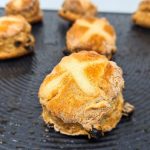These light and fluffy, well portioned scones are a great snack for kids to make over Easter. With no yeast, you won’t have to worry about proving the mixture, making them an easier and quicker alternative to the usual hot cross buns.
Skills Check
Follow a recipe; follow food safety and hygiene rules; tidy away; use a timer to cook correctly; crack an egg; beat an egg; rub fat into flour; handle and roll pastry; cut out rolled pastry; glaze pastry; use measuring spoons and jug; use weighing scales; use the oven (with adult supervision).
Equipment
20 x 30cm ovenproof dish/baking tray, weighing scales, measuring spoons, measuring jug, medium mixing bowl, wooden spoon, rolling pin, cookie cutter, small bowl, fork or whisk, pastry brush, piping bag or teaspoon.
Allergens (Please note the allergens listed are indicative only. Allergens vary depending on brand; check the labels on the products you use):
Wheat | Gluten | Eggs | Milk | Sulphites
Ingredients (makes 8):
- 225g self-raising flour
- 30g butter
- 15g sugar
- 30g raisins
- 125 ml semi skimmed milk
- 1/2 tsp salt
- 1/2 tsp cinnamon
- 1/2 tsp mixed spice
- 2 small eggs
For the crosses:
- 45g plain flour
- 30ml water
Method
- Pre-heat the oven to 220C/200C (Fan) and butter a 20 x 30cm oven dish or baking tray.
- Combine the flour, salt, mixed spice and cinnamon in a medium mixing bowl. Add the butter and rub in until combined
- Add the sugar, raisins and one of the eggs. Stir to mix.
- Add just enough milk, little by little, to form a stiff dough.
- Roll out the dough to a 2.5 - 3cm thickness and use a 5cm (2 inch) round cookie cutter to cut out 8 circles. Place in the prepared baking tray.
- Beat the remaining egg and using a pastry brush glaze the top of each scone with the beaten egg.
- Mix the flour and water together to make a paste, and pipe a cross onto each scone.
- Bake in the preheated oven for 15 minutes.
So thinking about Hot Cross Scones...

Keep portion sizes sensible.
Nutritional Information
| Energy | 697kJ/165kcal | 8% | |
| Med | Fat | 4.4g | 6% |
| High | Saturates | 2.4g | 12% |
| Med | Sugars | 6.2g | 7% |
| Med | Salt | 0.4g | 7% |
per 44g serving
% of an adult's reference intake
Typical values per 100g: Energy 1584kJ / 376kcal
Notes
A traffic light system is used on nutrition labels to make it easier to see which foods and drinks are lower in calories, fat, sugar and salt. Try and choose more ‘greens’ and ‘ambers’ and fewer ‘reds’, and stick to smaller portions of ‘reds’.
Just because a recipe or a food has a red traffic light doesn’t mean you shouldn’t eat it. Understanding why a food or recipe might have a red light can be helpful. For example oily fish is high in total fat and so any recipe containing oily fish is likely to be ‘red’ for fat. But it is recommended that we eat oily fish at least once a week because the type of fat it contains is beneficial for our health.
% Reference Intakes are also shown. Reference Intakes are guidelines about the approximate amount of particular nutrients and energy required for a healthy diet (based on an average-sized woman doing an average amount of physical activity). Most children will require less than these Reference Intakes. The contribution of one serving of a food or drink to the Reference Intake for each nutrient is expressed as a percentage.



